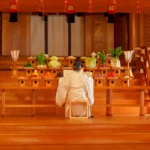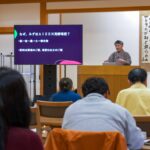Oomoto’s Mission
The first words of the Foundress’ writings announce that a new age of brotherly love is about to dawn, “like plum blossoms at winter’s end”. The present society of materialism and separatism is to be “reconstructed”. Mankind must return to Oneness and change forever its old ways of doing things or disaster will befall the world.
Shinto
In order to “reconstruct” the world, we need to return to our divine spiritual origins, hence the name of Oomoto, meaning “The Great Origin”. In Japan, returning to the origin means a return to the roots of Shinto, the ancient animistic faith which preceded Buddhism and is the indigenous faith of Japan. Thus Oomoto takes its ritual and fundamental doctrine from Shinto and is known officially as a form of “Sectarian Shinto”
Arts and Internationalism
From Shinto, with its passion for poetry and court ritual, came the love for and dedication to traditional arts which has come to typify Oomoto. At the same time, Onisaburo went beyond Shinto and brought teachings from Buddhism, Christianity, and other religions into Oomoto.
More seriously, Shinto as taught at Oomoto was a “return to the origins”, going back in time to the pure spirituality of ancient ages, before the rise of political insitutions such as the Imperial House. Shinto for Onisaburo transcended the Imperial system, and even Japan itself. Onisaburo saw Shinto as part of a universal religious revival destined to bring in the new age predicted by Nao.
| Bankyo Dokon
All Religions Spring from the Same Root There are many countries in the world, |
| |
Removing Intangible Barriers In order to build an everlasting peace for mankind, we must do away with all the barriers in the world, both tangible and intangible. Of the tangible barriers, the greatest are armaments for use against foreign nations (domestic police forces are another matter) and closed national boundaries. The greatest of the intangible barriers are those between one race and another, and between one religion and another. Before we can remove the tangible barriers, we must remove the intangible barriers. |
| Onisaburo Deguchi | ||



